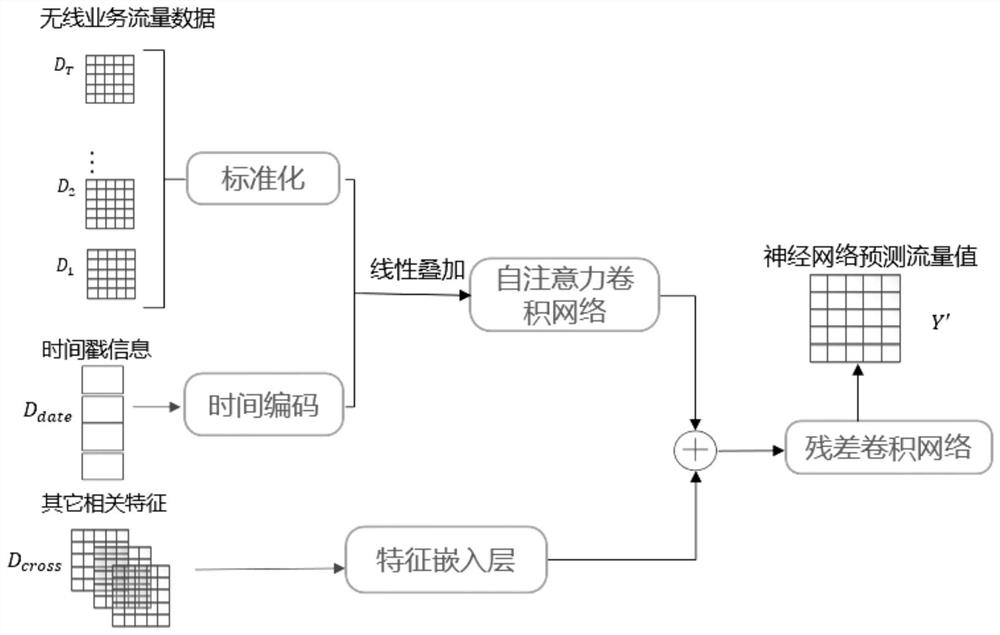Wireless service traffic prediction method and device based on self-attention convolutional network, and medium
A technology for wireless business and traffic prediction, applied in wireless communication, data exchange network, neural learning methods, etc., can solve the problems of difficult parallel implementation of prediction algorithms and low training efficiency, so as to improve traffic prediction performance, improve training efficiency, The effect of reasonable resource scheduling and management
- Summary
- Abstract
- Description
- Claims
- Application Information
AI Technical Summary
Problems solved by technology
Method used
Image
Examples
Embodiment 1
[0070] A wireless service traffic prediction method based on a self-attention convolutional network, which refers to: preprocessing the original wireless service traffic to be predicted and inputting it into a trained traffic prediction model to obtain predicted traffic data, the traffic data refers to traffic value;
[0071] The process of preprocessing the original wireless service traffic to be predicted includes:
[0072] Taking hours as the time granularity unit, using sliding time windows to divide the original wireless service traffic, so that the time span of each group of traffic data is T hours; The regional flow data are stored in the database in the form of a data matrix, and each set of processed flow data D′={D 1 ',D 2 ',...,D t '...,D T ′}, where the matrix H represents the number of grid rows, W represents the number of grid columns, the center of the grid is taken as the origin, and the matrix D t element d in ' t (h,w)′ Indicates the flow value of th...
Embodiment 2
[0075] According to a method for predicting wireless service traffic based on a self-attention convolutional network described in Embodiment 1, the difference is that:
[0076] The traffic prediction model includes temporal encoding network, self-attention machine convolutional network, feature embedding network and convolutional residual network; such as figure 1 As shown, the time coding network extracts the features in the timestamp information, and fuses the obtained features with the traffic data with a certain time span; the self-attention machine convolution network performs correlation analysis and feature analysis on the wireless traffic data at different time nodes. Representation; the feature embedding network extracts other relevant features; the convolutional residual network fuses the output of the self-attention machine convolution network with the output representation of the feature embedding network to obtain the predicted traffic Y' for the next period.
Embodiment 3
[0078] According to a method for predicting wireless service traffic based on a self-attention convolutional network described in Embodiment 1, the difference is that:
[0079] In order to improve the overall performance of wireless service traffic prediction, the training process of the traffic prediction model is as follows:
[0080] (1) Using hours as the time granularity unit, the original wireless service traffic is divided by using the sliding time window, so that the time span of each group of traffic data is T hours;
[0081] In the spatial dimension, different regions are spliced into a grid, so that the flow data of different regions in the same period of time are stored in the database in the form of a data matrix, and each group of processed flow data D={D 1 ,D 2 ,...,D t ...,D T}, where the matrix H represents the number of grid rows, W represents the number of grid columns, the center of the grid is taken as the origin, and the matrix D t element d in t ...
PUM
 Login to View More
Login to View More Abstract
Description
Claims
Application Information
 Login to View More
Login to View More - R&D
- Intellectual Property
- Life Sciences
- Materials
- Tech Scout
- Unparalleled Data Quality
- Higher Quality Content
- 60% Fewer Hallucinations
Browse by: Latest US Patents, China's latest patents, Technical Efficacy Thesaurus, Application Domain, Technology Topic, Popular Technical Reports.
© 2025 PatSnap. All rights reserved.Legal|Privacy policy|Modern Slavery Act Transparency Statement|Sitemap|About US| Contact US: help@patsnap.com



